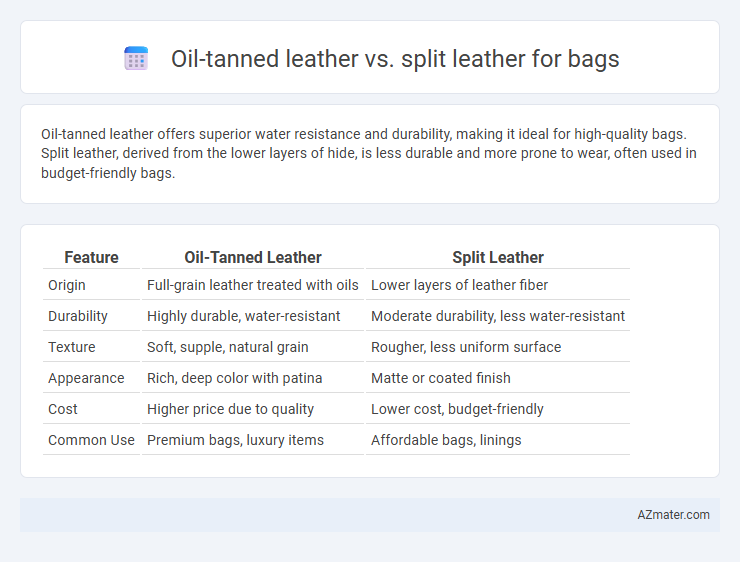Oil-tanned leather offers superior water resistance and durability, making it ideal for high-quality bags. Split leather, derived from the lower layers of hide, is less durable and more prone to wear, often used in budget-friendly bags.
Table of Comparison
| Feature | Oil-Tanned Leather | Split Leather |
|---|---|---|
| Origin | Full-grain leather treated with oils | Lower layers of leather fiber |
| Durability | Highly durable, water-resistant | Moderate durability, less water-resistant |
| Texture | Soft, supple, natural grain | Rougher, less uniform surface |
| Appearance | Rich, deep color with patina | Matte or coated finish |
| Cost | Higher price due to quality | Lower cost, budget-friendly |
| Common Use | Premium bags, luxury items | Affordable bags, linings |
Introduction to Oil-Tanned Leather and Split Leather
Oil-tanned leather is crafted by infusing oils and waxes into the hide during tanning, resulting in a durable, water-resistant, and supple material ideal for high-quality bags. Split leather, derived from the lower layers of the hide beneath the top grain, is less durable and often treated with synthetic coatings to mimic full-grain leather's appearance. The inherent qualities of oil-tanned leather offer superior longevity and a rich patina, while split leather provides an economical option with varied finishes but reduced strength.
What is Oil-Tanned Leather?
Oil-tanned leather is a type of full-grain leather treated with natural oils and waxes, which enhances its water resistance, durability, and suppleness. This leather undergoes a special tanning process that preserves the natural grain and allows it to develop a rich patina over time, making it an ideal material for premium bags. Compared to split leather, oil-tanned leather offers superior strength and a more luxurious feel, ensuring long-lasting performance and aesthetic appeal.
What is Split Leather?
Split leather is derived from the lower layers of a hide after the top grain has been separated, resulting in a more porous and less durable material compared to full-grain or oil-tanned leather. It often features a suede-like texture and is commonly coated or embossed to enhance its appearance and durability in bags. While split leather is more affordable and flexible, it lacks the natural strength and water-resistant qualities of oil-tanned leather, which is treated to produce a robust, long-lasting finish.
Durability: Oil-Tanned vs Split Leather
Oil-tanned leather offers superior durability compared to split leather due to its dense, tightly packed fibers and natural oils that enhance water resistance and flexibility. Split leather, derived from the lower layers of the hide, is less robust and more prone to wear and tear over time, making it less suitable for heavy-duty bag use. The enhanced toughness of oil-tanned leather ensures longer-lasting performance and better resistance to scratches and environmental factors.
Appearance and Texture Differences
Oil-tanned leather showcases a rich, deep color with a slightly glossy finish, providing a smooth yet supple texture that enhances durability over time. Split leather has a more fibrous, rougher surface with a matte appearance due to its lower-quality leather layer, resulting in a less uniform texture and reduced strength. The visual appeal of oil-tanned leather bags often conveys luxury and rugged elegance, whereas split leather bags appear more utilitarian and less refined.
Water Resistance and Weather Performance
Oil-tanned leather offers superior water resistance and weather performance compared to split leather due to its dense fiber structure and treatment with natural oils that repel moisture and prevent cracking. Split leather, made from the lower layers of the hide, lacks the protective oils and tight grain, making it more susceptible to water damage, staining, and deterioration in harsh weather conditions. Bags crafted from oil-tanned leather maintain durability and aesthetic appeal longer in wet environments than those made from split leather.
Maintenance and Care Requirements
Oil-tanned leather requires regular conditioning with specialized leather oils to maintain its water-resistant properties and supple texture, while split leather demands more frequent cleaning and protection due to its porous surface that is more prone to staining and wear. Split leather often needs a protective spray and gentle cleaning routines to prevent cracking and discoloration, as it lacks the robust finish of oil-tanned leather. Proper maintenance of oil-tanned leather enhances its durability and unique patina, whereas split leather's lower maintenance tolerance necessitates prompt care after exposure to moisture or dirt to extend its lifespan.
Cost Comparison: Oil-Tanned vs Split Leather
Oil-tanned leather is generally more expensive than split leather due to its durable full-grain quality and the time-intensive tanning process that enhances water resistance and longevity. Split leather, derived from the lower layers of the hide, is more affordable but lacks the premium texture and durability of oil-tanned leather. For bag production, investing in oil-tanned leather offers better long-term value despite the higher initial cost, while split leather suits budget-friendly options with compromised wear resistance.
Best Uses in Bag Manufacturing
Oil-tanned leather is prized in bag manufacturing for its durability, water resistance, and rich patina development, making it ideal for high-quality, rugged bags intended for outdoor and everyday use. Split leather, being more affordable and less durable due to its lower-quality fiber composition, suits budget-friendly bags and applications where aesthetic appeal outweighs heavy wear resistance. Manufacturers often choose oil-tanned leather for premium handbags and backpacks requiring longevity, while split leather is preferred for fashion-forward or lightweight accessories.
Which Leather Is Right for Your Bag?
Oil-tanned leather offers exceptional durability and water resistance, making it ideal for bags exposed to rough use and outdoor conditions, while split leather provides a more affordable, lightweight option but lacks the strength and longevity of full-grain tanned hides. Choosing between the two depends on your priorities: select oil-tanned leather for premium quality and ruggedness, or opt for split leather if budget and lightweight convenience are more important. Consider factors like daily wear, exposure to elements, and desired bag lifespan to determine which leather type best suits your needs.

Infographic: Oil-tanned leather vs Split leather for Bag
 azmater.com
azmater.com